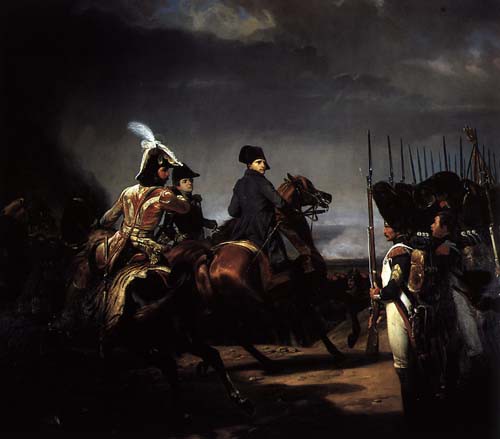The symbol par excellence of French monarchy, Versailles once again became a royal residence during the First Empire. Napoleon had the palace restored and made up his mind to spend every summer there but had to abdicate before having time to carry out his plan. Marie-Louise occupied the Trianon from 1810 to 1814 after marrying the Emperor. The Trianon is preserved in the state it was in during the First Empire.
In 1837, to enable the rival factions of France to make their peace, King Louis-Philippe decided to set up a museum “dedicated to all the glories of France” within Versailles. The museum which contains almost 6,000 paintings and 2,000 sculptures, is divided into 120 rooms in which visitors can admire almost all of the paintings Napoleon had commissioned to celebrate his own glory. Not a single episode is lacking in the historical reconstruction of the Consulate and the First Empire the museum provides. All events are covered from the first campaign in Italy to the second abdication.
Louis-Philippe himself decided to dedicate a room to the glorification of Napoleon. Thus, the Coronation room was installed at the exit of the Queen's apartments. Three prestigious paintings are exhibited around a Sèvres china column commemorating the victories of the Austerlitz campaign in 1805: first, a copy of the painting depicting the coronation which David worked on from 1808 to 1822 and which was installed in 1889 to replace the original painting sent to the Louvre; then the “Distribution of the Eagles” also by David; and “the Battle of Aboukir” by Gros. The center of the ceiling is decorated with an allegory of the 18 Brumaire by Callet, portraits of Bonaparte, general-in-command of the Army of Italy by Rouillard, a medallion of Josephine and Emperor Napoleon by Robert Lefèvre, and Marie-Louise's effigy.
In the 1792 room, Louis-Philippe assembled the portraits of the heroes of the Revolution and the Empire wearing the uniforms and badges of their ranks in September 1792 when the Republic was proclaimed. It is followed by the “Galerie des Batailles” which was built to counterbalance the “Galerie des Glaces”. The gallery acts as a kind of summary of French military history from the battle of Tolbiac in 496 to the battle of Wagram in 1809, and exhibits seven large paintings which are entirely devoted to the battles fought by the Empire: Rivoli by Philippoteaux, Zurich by Bouchot, Hohenlinden by Schopin, Austerlitz by Gérard and Wagram by Horace Vernet. A series of busts representing the generals and marshals killed in combat are presented with the paintings while large bronze tables list the names of all the soldiers who died for France.
The historical galleries enable visitors to follow the Napoleonic epic chronologically: small and medium-sized paintings are exhibited on the second floor in the attic known as the “Chamay” attic and in the southern attic. Large paintings are displayed on the ground floor of the southern wing. The visit starts off with an evocation of the campaign of Italy. A few works introduce the Consulate before visitors are led into the exceptional gallery containing portraits of the Bonaparte family: Charles Bonaparte, Napoleon's mother, Napoleon I, Josephine, Joseph, Jerome, Elisa, Pauline, Caroline, Murat and Julie Clay are immortalized in ceremonial dress by Gérard, Girodet, Lefèvre, Lethières and Mme Vigée-Lebrun.
The historical evocation of the Empire follows thanks to a series of paintings recalling great political and military events: the third coalition, the campaigns in Poland and Prussia, the campaign in Austria, Napoleon's wedding with Marie-Louise, the King of Rome's birth, the war in Spain, the campaign in Russia, the fall of the Empire and the exile of the Bonaparte family. Rooms devoted to the administrative services of the period and the fields of arts and sciences completes this panorama. The visit continues with various rooms containing large paintings arranged in chronological order.
The Second Empire is also evoked in the historical rooms thanks to the portraits of Napoleon III and Eugenia by Winterhalter; the paintings portraying the Empress and princess Mathilda by Dubufe; and the evocations of the campaign in Italy, the campaign in Mexico and the war of 1870.
Museum and National Estate of Versailles and the Trianon.


